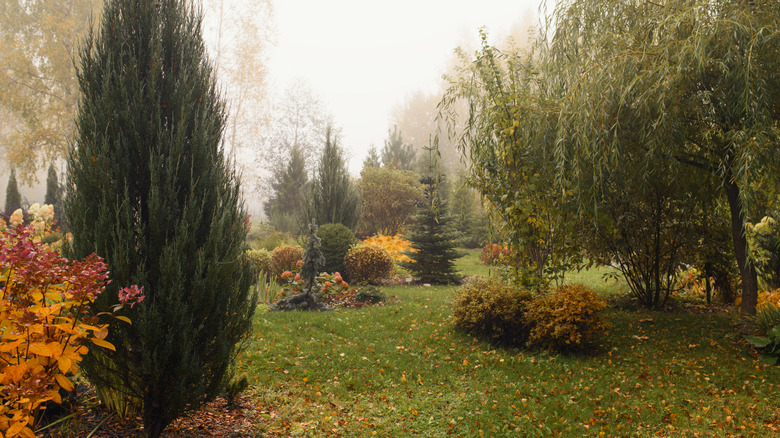The Evergreen Shrub With Stunning Fall Foliage And Gorgeous Flowers In Spring
Tis the season for beautiful fall foliage as many look forward to the vibrant hues that autumn has to offer. But when winter sets in, we wait for those first buds of spring to blossom. It makes sense that the best plants to have in your yard are ones that offer the best of both worlds — those that produce lovely growth in the fall and knockout flowers in the spring. This is why gold dust would be a desirable addition to your garden.
Gold dust (Aucuba japonica), also known by other names such as Japanese laurel, spotted laurel, or blotched-leaved laurel, is native to Taiwan, China, and Southern Japan, and grows best in hardiness zones 6 to 9. This evergreen shrub has specks of yellow on its large, dark green leaves. It is attractive in every season, but especially in the fall, when it produces bright red berries that hang around through winter, and in early spring, when it sprouts tiny purple-maroon flowers.
In addition to looking lovely as a great evergreen to brighten up your yard year-round, gold dust shrubs are also low-maintenance. In the right conditions, these perennials can live for up to 50 years. One word of caution — gold dust is mildly toxic and can cause upset stomach if accidentally ingested by humans or pets. However, garden pests such as deer and rabbits tend to avoid the bitter-tasting plant.
How to incorporate gold dust in your garden
If you're ready to add gold dust into your landscaping, look for the right spot. These shrubs love areas with plenty of shade, making them a perfect fit to fill those dark corners. They thrive in moist, rich soil, but are adaptable enough to grow in various types, including gardens with clay soil. Once you've selected the location, you're ready to plant. Gold dust shrubs can grow between 6 to 10 feet tall and 5 to 9 feet wide, so they're a good option for someone who wants to create a privacy hedge or border. If you're adding multiple gold dusts to your yard, plant each one about 2 to 3 feet apart, and about 5 feet apart from other plants. And if you want those lovely red berries in the fall, you'll need to incorporate both male and female shrubs in your yard, since it's the female plants that sprout the berries when pollinated by their male counterpart.
To care for your gold dust shrubs, initially water them frequently, deeply, and slowly, so that the soil is consistently moist but without any standing water. Once the shrubs are well-established, they become more drought-tolerant but still benefit from regular watering sessions. And since gold dusts grow slowly, they don't need regular pruning, but should be trimmed once or twice a year, especially in the early spring, to maintain the desired shape.

